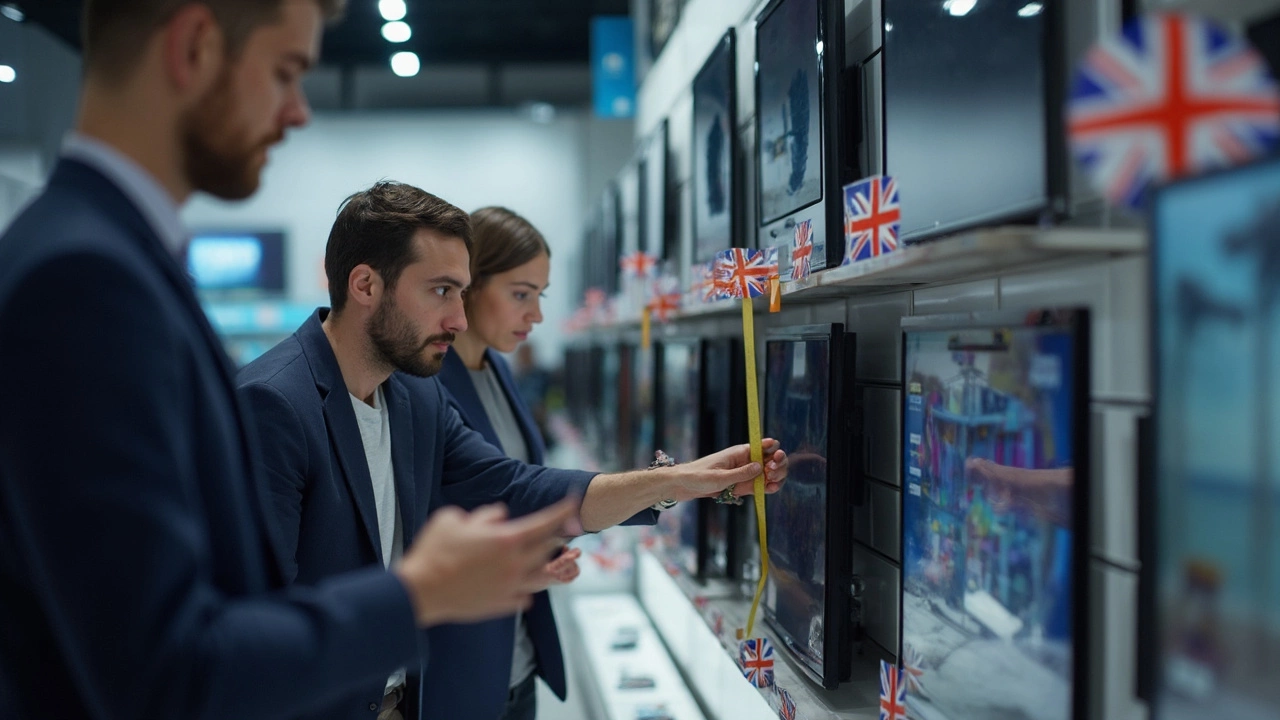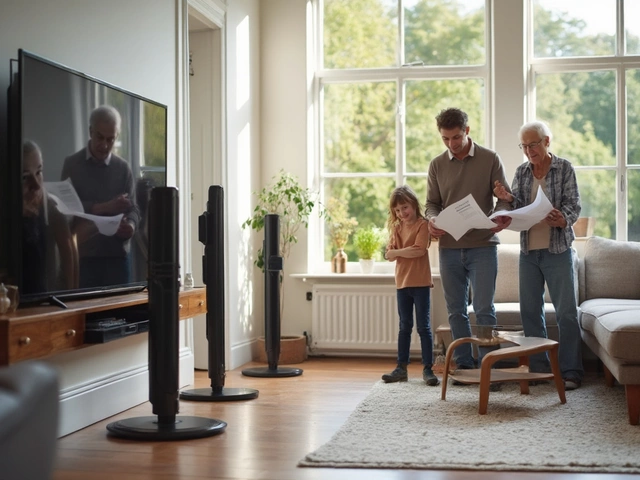Do All Samsung TVs Use the Same Stand? What You Need to Know

Ever thought all Samsung TVs shared that signature stand? Yeah, not quite. It actually gets messy fast—putting a 55-inch QLED’s legs on a 43-inch budget model just isn’t going to work. Even two TVs from the same series can come with completely different stands or mounting holes. It’s not just about style; it’s about engineering, weight, and balance.
If you’re swapping out your old stand for a newer look, or you lost the original screws (we’ve all been there), you’ve absolutely got to double-check the model number. Not just the series, but the full code. Samsung loves to mix up tiny details year to year. Some stands have wide feet at both ends, others have a central pedestal, and those legs aren’t always spaced evenly or at the same distance apart. Even the screws sometimes change size—super annoying if you’re in a hurry.
- Why Samsung TV Stands Aren’t the Same
- Spotting Compatibility: What to Check
- Swapping or Upgrading Your Stand
- Tips for Safe and Stable Setups
Why Samsung TV Stands Aren’t the Same
The idea that all Samsung TV stands fit every Samsung TV is wishful thinking. Samsung builds dozens of series every year—QLED, Crystal UHD, The Frame, The Serif, you name it. Each one is designed with a unique look and different mounting needs. That means you’ll run into a ton of variation, and not just because of screen size.
Here’s what really sets them apart:
- Design choices: High-end Samsung TVs often use central pedestal stands so the screen can swivel or sit on narrower furniture, while entry-level and mid-range models usually have wide legs on each side. The Frame and Serif have legs that fit their unique “furniture-style” bodies.
- Weight and balance: Heavier TVs with bigger screens or built-in soundbars need robust stands with a broader base or thicker screws. Lighter models can make do with smaller, simpler legs.
- Attachment points: Even if two TVs measure 55 inches diagonally, the placement and size of screw holes on the back almost always differ—sometimes by just a centimeter, sometimes way more.
- Model year tweaks: Samsung updates feet and mounting hardware just about every year. The same model name but a newer year can mean totally different stand designs and screw types.
Just to give you an idea of the variety, take a look at this quick breakdown of Samsung stand types in recent years:
| Model Series | Common Stand Type | Year |
|---|---|---|
| QLED QN90A | Central Pedestal | 2021 |
| Crystal UHD TU7000 | Wide Separate Legs | 2020 |
| The Frame | Flat "Art" Legs | 2022 |
| The Serif | Easel-style Legs | 2023 |
The key takeaway? There’s no universal Samsung TV stand. If you want to swap stands or upgrade, checking compatibility is a must—or you risk ending up with something that just won’t fit.
Spotting Compatibility: What to Check
It’s easy to think any old stand will fit a Samsung TV, but don’t trust your eyes—there’s a science to Samsung TV stands and their fit. Here’s how to make sure you don’t end up with a wobbly setup or a stand that doesn’t even attach.
- Check the Full Model Number: Every Samsung TV’s model number tells you its year, size, and sometimes special features. This is the code you’ll usually find on a sticker at the back. Matching stands is nearly impossible without this number.
- Leg and Screw Spacing: The space between the legs or mounting holes can be totally different even for TVs that look similar. Don’t just eyeball it—grab a tape measure. Some 55-inch models spread the feet right to the edge while others keep them closer to the middle.
- Screw Size and Thread: Screws aren’t one-size-fits-all. Samsung often uses M4 or M8 screws, but you can never tell by touch alone. Double-check the TV manual or Samsung’s support page for the exact type—you don’t want loose, unsafe legs.
- Weight Support: Stands aren’t just about fitting—they have to hold the TV safely. A smaller or older stand might buckle under a newer, heavier model. Always check the maximum TV size and weight the stand can handle, especially if you’re buying one online or secondhand.
- Style and Shape: Some TV stands (especially center pedestals) are model-specific. Don’t try to mix and match curved feet with straight slots. It usually won’t work without drilling new holes, which kills your warranty.
Here’s a quick look at some differences in stand compatibility by size and model year:
| TV Size | Model Year | Foot Spacing (cm) | Stand Type |
|---|---|---|---|
| 43" | 2021 | 78 | Wide foot |
| 50" | 2022 | 86 | Central pedestal |
| 55" | 2023 | 107 | Edge legs |
Bottom line: don’t play the guessing game when it comes to TV compatibility. One wrong fit can waste money, or worse—risk your screen crashing to the floor. Always cross-check details before clicking ‘add to cart.’

Swapping or Upgrading Your Stand
If you’re hoping to swap or upgrade your Samsung TV stand, you need to watch out for a few quirks. Swapping stands between TVs isn’t as simple as just grabbing any set of legs and screwing them in. Samsung has dozens of stand shapes, mounting patterns, and screw sizes across models. Even TVs with the same screen size might use a totally different stand type from year to year.
Start by checking the exact model code stamped on the back of your TV. This tells you which stand fits—don’t rely just on the general product name. Once you have that, hit up Samsung’s official parts website or look for the model's support manual online. These resources will tell you which stands and screws actually fit your specific TV.
Thinking of buying a used or universal stand online? Hold up. Not all so-called “universal” stands are a perfect match, especially on weight balance or screw spacing. If you want to use a third-party TV stand, look for something built to the VESA mounting standard. Most current Samsung TVs list their VESA pattern in the manual or online—it’s usually in millimeters, like 200x200 or 400x400. Matching the VESA spec between your TV and stand’s mounting brackets is key for stability and safety.
Here’s what else you should do before you start swapping:
- Double-check the stand’s maximum weight capacity. Even if the screws fit, a stand rated for smaller TVs might be risky with your heavier set.
- Compare leg width and depth—some TVs have wide-set legs that need extra-wide furniture, or your TV could teeter if moved to a tighter stand.
- Save your original screws! Samsung can use slightly different screw threads or lengths by model, and replacements from a hardware store aren’t always a guaranteed fit.
For folks who lost their original stand, you can order official replacements straight from Samsung or shops like PartsDr or Encompass Supply. Prices in 2024 ranged anywhere from $30 to over $100 for the official part, depending on model and how many pieces are included.
| TV Model | Original Stand Type | VESA Pattern | Replacement Cost (2024) |
|---|---|---|---|
| Samsung QN55Q60B | Wide feet (ends) | 200x200 mm | $85 |
| Samsung TU7000 | Central pedestal | 200x200 mm | $42 |
| Samsung AU8000 50" | Wide feet (ends) | 200x200 mm | $59 |
If you want a simple upgrade, consider adjustable TV mounting kits that let you change the foot position or height—handy for extra soundbar space. Just make sure the kit lists your exact TV size and VESA specs.
Tips for Safe and Stable Setups
Setting up your Samsung TV stands right isn’t just about looks—it's about making sure your screen doesn’t take a dive off the cabinet. Even a light bump can send a TV crashing if the stand isn’t snug and stable. Let’s keep that from ever happening at your place.
- Match the exact model: Always use the stand that came with your TV model. Swapping stands from a different size or year? Double-check compatibility, because screw holes and leg gaps move around a lot from version to version.
- Screw it down tight: Don’t eyeball it—use the screws Samsung includes, because they’re not always standard size. Using the wrong screw can strip the threads or wobble loose over time.
- Surface matters: Your stand’s only as good as the furniture under it. Make sure your TV’s on a surface that doesn’t bow under weight or rock when pushed. IKEA furniture might look nice, but watch for particleboard bowing on wide units.
- Cable wrangling: Don’t let power cords hang so they tug the TV backward. Always leave a little slack and route them neatly, so no one can trip or yank your TV by accident.
Sometimes kids, pets, or even vacuum cords wind up putting your setup to the test. Want a safer bet? Use anti-tip straps—they’re cheap insurance you screw to the back of the TV and anchor to the wall or furniture. These little things have kept a lot of expensive TVs upright.
| TV Size | Recommended Stand Leg Width (Min) | Suggested Furniture Depth (Min) |
|---|---|---|
| 32"–43" | 14" | 10" |
| 50"–55" | 24" | 12" |
| 65"–75" | 34" | 15" |
If you’re tempted to wall mount instead, that’s usually even safer—just read the manual or look for VESA standards (hint: most Samsung models use 200x200mm to 400x400mm VESA patterns, but always confirm).
With a proper match, tight fasteners, and a little common sense, your TV won’t become a living room hazard—and you won’t be filing an insurance claim over a toppled screen.
